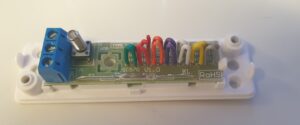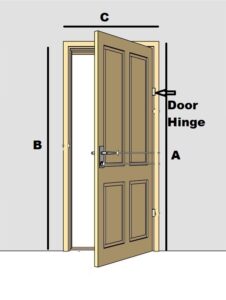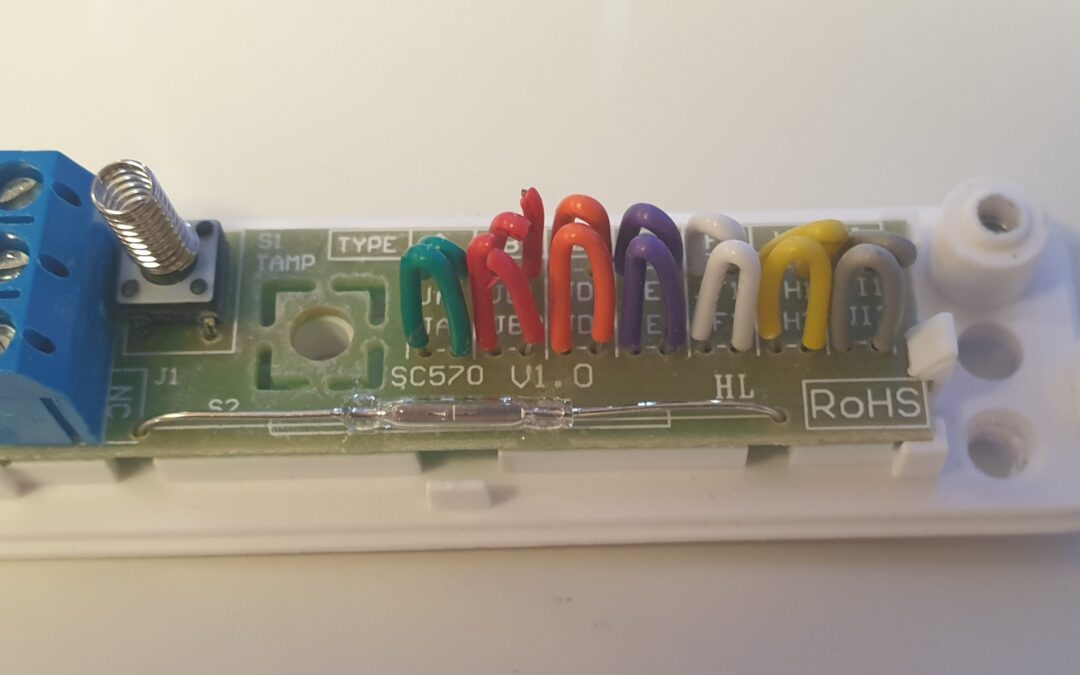How does a door contact work?
Door Contacts
The word “alarm contact” refers to a variety of devices that are all designed to accomplish the same job. When an alarm contact is triggered by an external force, it changes the state of an alarm loop. This concept encompasses not only door and window contacts, but also pressure pads, personal attack switches, mechanical vibration contacts, and a variety of additional devices that aren’t typically referred to as contacts.
Door contacts are used more often than any other detectors. The selection of a good quality door contact and accurate placement of the devices is vital if the detectors are to do their job successfully.
Magnetic Reed Switches
In general, open magnetic reed switches are the most widely utilised alarm contacts. Two ferromagnetic (e.g. nickel-iron) reeds are hermetically sealed in a glass tube to form the basic reed switch. With a slight gap between them, the reeds’ ends aligned. The ends of the reeds assume opposite polarities when an external magnetic force is applied, and when the force is high enough, the tips of the reeds within the tube are mutually attracted and joined into contact. The reeds are quite springy, so as soon as the magnetic force is withdrawn, they part again. The glass envelope is filled with an inert gas to keep contamination out, and with the right contact materials, it has an extremely long life.
The contacts make very quickly due to the low inertia of the reed blades and the narrow gap between them, with typical operating times of 1,000ths of a second for miniature types and 2,000ths of a second for regular ones. The effect of the contacts on closure causes a millisecond-long phenomenon known as “contact bounce.” The effect grows in proportion to the amount of magnetic force applied, but the operating period decreases.

We are more concerned with the behaviour of the reed when the magnetic field is withdrawn because most reeds are used in a usually closed configuration, which means that the opening of the reed contact triggers an alarm condition. Hysteresis, or magnetic inertia, is present in almost all magnetic devices. After the reed switch has closed, it requires less magnetic force to keep it closed than it did to close it in the first place. To put it another way, it takes more force to get the reed blades to shut than it does to keep them closed once they are in touch.
The amount of magnetic force required to operate a reed switch is affected by several factors in the mechanical construction, including the reed material, contact material, overlap, and gap. Because reed switches are generally operated by the magnetic field from a coil enclosing the glass envelope for uses other than alarm contacts, switches are provided in bands of pull-in sensitivity. As a result, the abbreviation AT refers to the measurement of reed switch sensitivity in ampere-turns. The switch’s sensitivity increases as the number of ampere-turns decreases.
Although modern magnetic materials ensure that, once the correct magnet is selected, it will perform satisfactorily for many years. The magnets used in alarm applications are manufactured to commercial tolerances, which must be taken into account when choosing a suitable reed/magnet combination. Shock, extreme temperatures, and the magnetic field from electromagnets or other permanent magnets all lower the actuating magnet’s strength as the strength of the alarm contact may deteriorate to the point where it causes problems.
The designer must choose a contact material that is appropriate for alarm applications. Reed switches typically come in at least three distinct contact materials, with the most popular being plated rhodium or silver. Rhodium has a low and consistent contact resistance, and its high melting point allows it to switch inductive loads such as relays. When switching inductive loads, silver likewise has a low contact resistance but is more sensitive to arcing. Alarm applications should be utilised with caution when using reeds with gold plated or diffused gold contacts.
When it comes to magnetic reed contacts that are used in the most obvious scenarios, make sure the installed door contact works properly in two key areas:
- The door contact on the door or window must not allow a clear opening of more than two inches without triggering an alarm.
- When the magnet is less than 3/8in away, the contact should open and close at a distance of not more than three times the working distance.
When the contact activates, you should hear a ‘click’.
A weak magnet or an insensitive switch may prevent movement or shaking of the door or window, resulting in false alarms. A powerful magnet may allow access to the alarm wire or the contact itself if the door or window is opened sufficiently.
Reed switches are normally flush-fitted in the door or window frame and are enclosed in plastic or metal containers. The reed is shielded from external magnetic fields by utilising a ferrous metal casing. This prohibits any magnet other than the linked actuating magnet from operating. The reed blades are often cut to reduce the size of the device when it is placed in a container. Cutting in this fashion alters the magnetic circuit of the switch and lowers the sensitivity.
As a result, the designer must account for this and employ a stronger actuating magnet. Cropping and/or bending the blades should be done carefully, and the blade should be tightly secured near the envelope to ensure that the hermetic seal is not stretched. Failure to do so, or attempts to crop too close to the seal, can cause the envelope to fracture, causing the contact to misalign and the inert gas to escape. It’s never a good idea to use a cracked reed.
Siting and installation of such contact
After ensuring that the contact is performing as it should, there are a few more important considerations in the siting and installation of such a contact. The figure above shows a door and door frame, as well as possible contact installation locations. What are the advantages and disadvantages of these positions? The position of alarm contacts is determined by two basic considerations. The switch should be placed so that proper operation is ensured without jeopardising the premises’ security. A contact installed in any orientation with the actuating magnet in the` side of the door may allow severe rattle and shake without causing a false alarm.

It’s possible that you won’t be able to open the door enough to activate the contact at all. This site may be good for the installation engineer who is concerned about the amount of play in the door catch, but it defies the contact’s original purpose. On the other hand, if the door can move enough on its catch, a touch in position B on the same door may cause problems. We’re left with C, the top of the door. Movement of the door on its catch will not influence the switch if contact is fixed in the lining of the architrave 6 to 9 inches away from the hinge end of the door (Pint X), but it will not allow the door to open considerably without sounding an alert.
Reeds can be mounted either parallel to the magnet’s axis, as shown in Figure, or parallel to it. The installing engineer benefits from end-on mounting because the switch can be accommodated by simply drilling a hole. When drilling the magnet hole in panelled doors, take care to drill only a blind hole, as magnets have been known to go down inside the door! Normally, parallel mounting needs the use of a chisel.
If the switches are contained in a plastic container and carefully recessed, a coat of paint may make them unnoticeable to the untrained eye. On the other hand, some security installers chisel a recess, install an unencapsulated reed switch, and then fill the hole with a proprietary filler. There are two potential drawbacks to this method. To begin with, if the filler compound is quite wet when mixed, it may take several days to completely dry out. This can be a concern on two levels, especially when using transistorised control equipment. The retained moisture could create a conductive conduit for the reed to shunt, or electrolytic activity could occur where the alarm wiring meets the reed blades. Second, if a filler compound with a high rate of shrinkage is utilised, the glass envelope may be subjected to enough force to crack. Although it is of greater relevance to control unit designers than to anyone else, it is worth noting that electrical action is not the only source of voltage that can be generated in the alarm loop. This occurs at the intersection of the reed blade’s nickel-iron and the copper wire used for the alarm loop and is typically in the range of 40 microvolts per degree Celsius. In comparison to the voltages that can be generated in alarm loops near mains wires, this is a minor amount of voltage. Regardless of the method used to install the contact, it should be concealed and unavailable.

